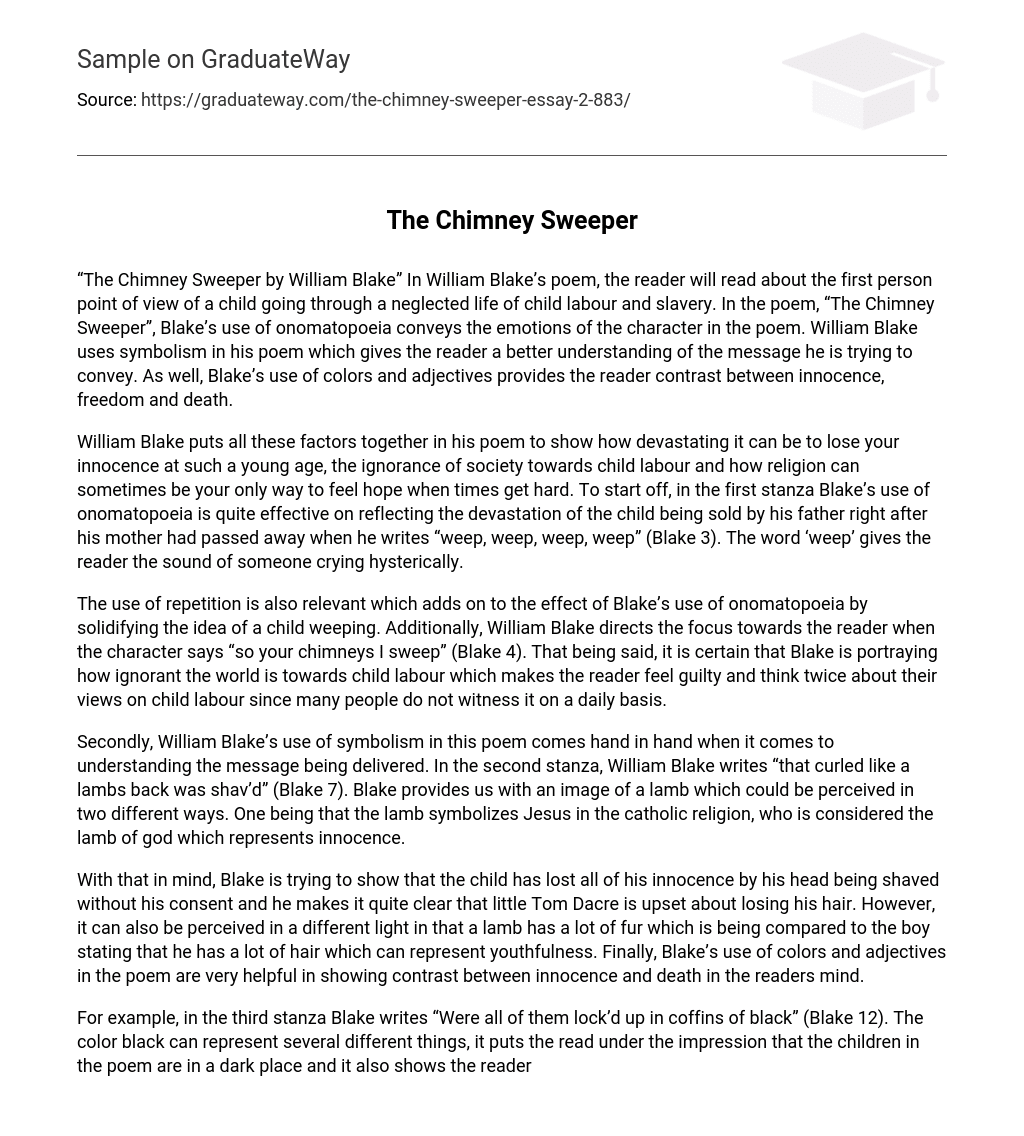William Blake explores the perspective of a child living a life of child labor and slavery in his poem “The Chimney Sweeper”. Through the use of onomatopoeia, Blake effectively conveys the emotions experienced by the character in the poem. Additionally, symbolism is employed by Blake to enhance the reader’s comprehension of the underlying message. Furthermore, by utilizing colors and adjectives, Blake skillfully presents a contrast between innocence, freedom, and death.
William Blake addresses the various factors in his poem to illustrate the immense impact of losing one’s innocence at a young age, the society’s obliviousness towards child labor, and the occasional reliance on religion to find solace during difficult times. Firstly, in the initial stanza, Blake employs onomatopoeia remarkably well to portray the devastation experienced by the child who is sold by his father immediately after his mother’s demise as he writes “weep, weep, weep, weep” (Blake 3). The term ‘weep’ conveys the sound of someone crying uncontrollably.
The use of repetition enhances the impact of Blake’s onomatopoeia, reinforcing the image of a weeping child. Furthermore, Blake shifts the attention onto the reader through the character’s statement, “so your chimneys I sweep” (Blake 4). Thus, Blake effectively portrays the world’s indifference towards child labour, instilling guilt in the reader and prompting them to reconsider their stance on this issue, as it is not commonly witnessed in daily life.
Additionally, the utilization of symbolism by William Blake in this poem coincides with the comprehension of its conveyed message. In stanza two, Blake articulates, “that curled like a lambs back was shav’d” (Blake 7). This line constructs a mental picture of a lamb that can be interpreted in two manners. Firstly, the lamb can symbolize Jesus in Catholicism, who is revered as the lamb of God signifying purity and innocence.
Blake’s intention is to demonstrate that the child’s innocence is completely gone, as evidenced by his head being shaved against his will. The poet explicitly portrays little Tom Dacre as distressed by the loss of his hair. However, another interpretation could be that the poet compares the abundance of a lamb’s fur to the abundance of the boy’s hair, symbolizing youthful vitality. Additionally, Blake effectively uses colors and adjectives throughout the poem to highlight the contrast between innocence and death in the reader’s perception.
In the third stanza, Blake uses the phrase “Were all of them lock’d up in coffins of black” (Blake 12) as an example. The color black carries multiple meanings here. It conveys that the children in the poem are in a dark place, and it also suggests that death is the only way for them to escape their suffering. This idea is reinforced in the fourth stanza when Blake writes about an Angel who possesses a bright key.
Blake’s choice of the adjective “bright” implies that the children are being rescued, possibly indicating their ascent into heaven. This aligns with the idea that people often speak of a light at the end of the tunnel or seeing a bright white light upon death. Blake also employs colors to create an impression on the reader. For instance, he writes “Then naked and white” (Blake 17), suggesting that the children are as pure and innocent as they were at birth, which was taken from them when they were sold by their parents.
In summary, Blake effectively employs onomatopoeia, symbolism, colors, and adjectives to portray the devastating emotions experienced by children who are sold by their parents and thrown into a cruel world of child labor. Blake demonstrates how a child’s innocence can be easily snatched away without their awareness, and highlights society’s ignorance towards this issue. To find solace and hope amidst such darkness, children often turn to their faith in God.





